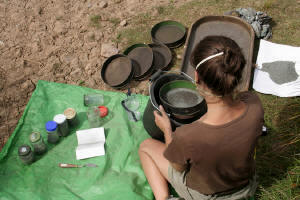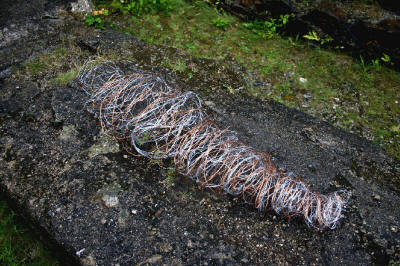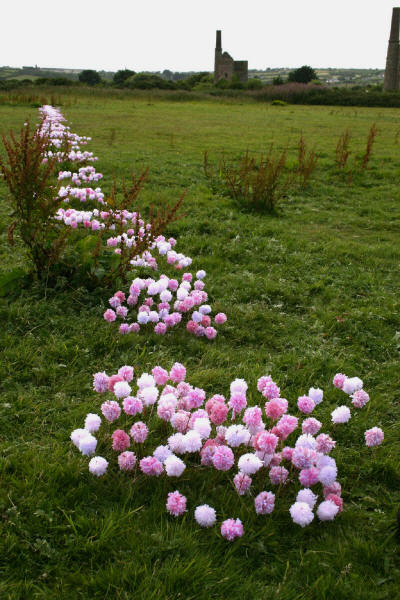| art-cornwall | ||
| home | features | exhibitions | profiles | gazetteer | links | archive | ||
| Wheal Art Weekend Wheal Frances, July 29th and 30th, 2006
'Wheal Art' was an artist-led project, and one of the most ambitious of its kind ever seen in Cornwall. Eleven artists cooperated with one another to make art within the setting of the former mine workings of Wheal Frances, deep in the old industrial heartland of Cornwall. Paul Chaney set up a field tent and collected evidence of mining-like animal activity, especially digging and burrowing on the site. This was displayed in the tent by means of polaroids and written notation. Andy Whall (left above) responded intuitively to the location by using performance and arcane materials such as bark chippings, feathers, honey and chalk. Kate Ogley showed pairs of gloves attached to a motorised wire that jumped about involuntarily when a visitor approached, and Rebecca Diss (right above) used iron pigments to colour the architecture of the mine workings a luscious red.
Alison Sharkey, the lead artist for the project, installed a video of balls bouncing joyfully in an echoing, damp, cavernous space in the mine. The thrift flower, which is thought to prefer mineral-rich soil, was used as inspiration for Sara Bowlers (above left) piece, in which the flower was remade out of pink wool, and arranged in characteristic clumps in the ground, as if marking tin-rich deposits beneath. Stephanie Boon (second right above) turned one of the mine buildings into a chapel of rest, by placing a hollow child-size effigy made in metal wire on a cold stone slab. Closer inspection revealed a dead bird, like the soul, trapped inside and being blown helplessly by the wind. Steven Paige installed a complementary pair of sound pieces: in one the anguished sound of pure tin cracking (the 'tin-cry') was projected down into the depths of the longest mine-shaft, and in the other original media recordings relating to the slump in tin prices in 1985 were played such that they filtered up one of the chimneys.
Alexis Zelda-Stevens (right above) installed large shapes formed mainly of board and grass-turf that reflected and offset the buildings, and somehow brought the landscape further into the fabric of the mine. Stacey Righton (centre above) used authentic tools to break up and sift pieces of copper ore recreating a technology that would have been commonplace in the early years of mining in Cornwall. In the car-park visitors were invited by Oliver Sutherland to send messages to relatives or loved ones using the primitive technology of a tin-can transmitter as part of the ongoing 'art in-transit' project. Artists that depict Cornwall and its landscape, typically in paint, are many. Artists that try to understand its history or help us see it afresh are a rarer breed, and each of those who participated in Wheal Art, despite the weather (it rained!) should be applauded for their imaginative and bold individual contributions.
|





